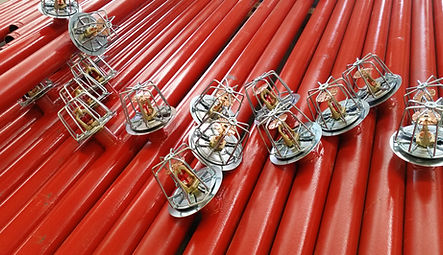Fire safety
There are four types of fire risk assessments that apply to residential blocks of flats or apartments.
Type 1: Common Parts (Non Invasive)
A basic fire risk assessment of the communal managed areas of a residential property. This is the usual standard of fire risk assessment carried out to most residential blocks unless deficiencies in fire protection are suspected.
Type 2: Common Parts (Invasive)
Similar to type 1, except with an element of invasive inspection with sampling carried out to check the separating construction of the property.
Type 3: Common Parts and Flats (Non Invasive)
Assessments of this type cover the communal areas, as well as within flats. Consideration will be given to means of escape and fire detection (smoke alarms etc) across a sample of flats.
Type 4: Common Parts and Flats (Invasive)
This type of assessment covers the scope of type 3 but with an added degree of invasive inspection, in both the common parts and within flats, on a sampling basis. This is the most comprehensive type of fire risk assessment.
sprinklers
Evidence from fire safety experts suggests that where there are sprinkler systems fitted death from fire is an extremely rare occurrence.
Currently, only buildings erected after 2007 and more than 30 metres (98 ft) high are required to be fitted with sprinkler systems.
While some local authorities have been retrofitting sprinklers to some of their blocks, the main obstacle is clearly the cost, although no detailed research appears to have been conducted to establish how great this would be.

The British Automatic Fire Sprinkler Association estimates that the cost of fitting a system in Grenfell Tower would have been around £200,000.
Previously, the association found that fitting a system to 47 flats in Callow Mount, a 13-storey block in Sheffield, South Yorkshire, came to £55,000, or £1,150 per flat.
Additionally, the cost of maintaining the sprinkler systems and regularly checking that they work needs to be taken into account.
On 12th March 2019, a government debate took place discussing sprinkler systems, click on the image to watch the debate in full.
Introduction to fire safety survey 1990
As early as 1990 The National Tower Blocks Network were raising concerns about fire safety in tower blocks. This report documents our findings at that time.
There were major fires in January and July 1990 in flats at Merry Hill Court, Smethwick, West Midlands. A woman died in the second of these fires and this Fire Safety Assessment by architect Sam Webb was submitted as evidence to her inquest.
Sam Webbs assessment of the Merry Hill Court flats found structural defects, the absence of separate compartmentalisation which led to the rapid spread of fire and inadequate means of escape and fire-fighting equipment.
This report also highlights non compliance with the British Standard Code of Practice and a range of fire hazards which he subsequently identified in spot surveys of tower blocks in five different locations in the Cities of Manchester and Sheffield and the London Boroughs of Redbridge, Tower Hamlets and Wandsworth.
Concerns about Fire Safety in your block?
Many local Fire & Rescue Services around the UK offer Free Home Fire Safety Visits for vulnerable people.
These visits include learning about what to do to reduce the risks of fire, checking smoke detectors are working (some vulnerable residents may also be eligible to have smoke alarms fitted free of charge) and putting together an escape plan in case a fire does break out.
Click on the image to find out more about the service that London Fire Brigade offer, or click here to find your local Fire and Rescue service in the UK.
The award-winning Fire Door Safety Week campaign aims to stamp out the legacy of neglect of fire doors across the UK, while raising awareness of the crucial role that fire doors play in protecting lives. It reached a new high in 2018, gaining support from more than 350 individuals, organisations and businesses, and reaching millions through press coverage and social media activity. The campaign also achieved a great deal of influence online, with tweets reaching more than 1.5 million Twitter users, and the hashtag #FireDoorSafetyWeek achieving 500k impressions.
Inside housing webinar series
Inside Housing, in partnership with Rockwool have produced a webinar series on fire safety. Click on the image to redirect to the Inside Housing website.
Publications and articles
London Fire Brigade seek changes in the law to stop developers from consistently ignoring their advice on sprinklers. Inside Housing 11/02/19
London Borough of Tower Hamlets to use new enforcement powers against tower block owners, forcing them to remove dangerous cladding.
Inside Housing 19/02/19
Phil Murphy, former firefighter, fire safety officer and tower block resident writes a guest blog post for the University of Oxford discussing fire safety and the stigma of tower block residents. Read more about Phil's work on his 'Real Voices' blog here.
A Labour party investigation reveals that only 4% of London council-owned tower blocks are fitted with sprinklers. Inside Housing 23/11/18
Inside Housing investigate how and why so many buildings ended up being fitted with dangerous cladding.
08/03/19
High Rise Fire is an educational website which aims to be a one-stop resource for those involved in fire prevention in high rise buildings.
July 2019, The BBC report from a block in Oxford with non-ACM cladding which has failed fire tests. The cladding is HPL (High Pressure Laminate) - the same used on Lakanal House.
August 2019, Inside Housing report on recent timber frame building fires and highlight their safety shortfalls.


_edited.png)


.png)

_edited.png)
_edited.png)
_edited.png)
_edited.png)
_edited.png)
_edited.png)
_edited.png)